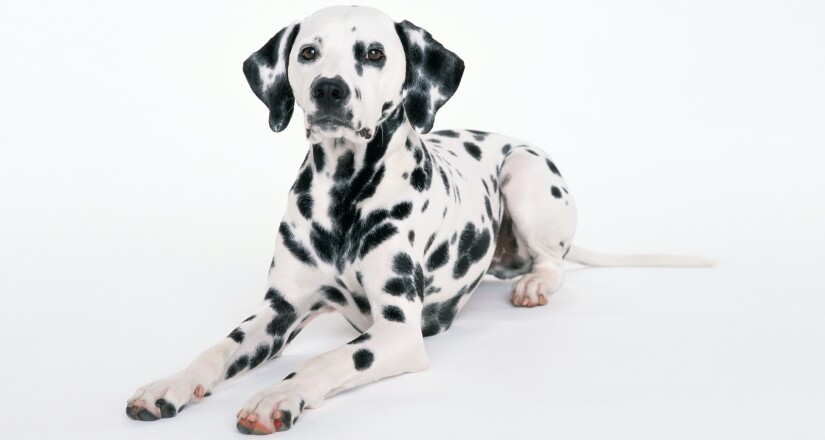Dalmatians are medium-sized dogs with a smooth coat and unmistakable black dotted coat. This unique feature comes in two possible colors – either black or liver (chocolate brown).




Dalmatians like to keep themselves clean and hold almost no odor. They shed year-round and should get regular brushing during this period to minimize shedding.
These canines have become famous both as movie stars and as the firefighter’s best buddy. Contrary to popular belief, these dogs are smart and cunning. They are not very easy to train because they are not exactly motivated to obey you.
Temperament
They are territorial but not aggressive. The breed is quite hardy and doesn’t require much upkeep. Dalmatians are people-oriented and they love to be in the center of attention, at the family’s side.
He will feel very bad if left alone outside or on a chain. They can’t stand being ignored and will quickly develop weird behavior if you do so. They also have a really short coat that makes them somewhat vulnerable to extreme weather.
Some people think that owning a dog consists of keeping him outside and patting him when you feed him. However, dogs are social animals that want constant reinforcement of their position in the pack.
Contrary to popular belief, Dalmatians are quite intelligent and learn to obey new commands relatively quickly. Obedience training and socialization are very important so make sure your dog gets plenty of it. Dalmatians are great apartment dogs but are not limited to this type of residence.
What are they like to live with in an apartment?
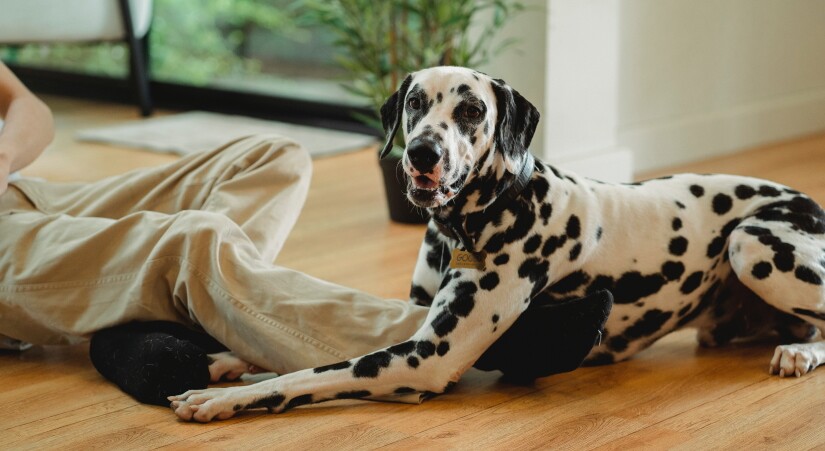
They can adapt to almost any environment. Be it an apartment, house or farm you can be sure they will be happy, as long as you provide good conditions. They are very high-spirited and will actively search for ways to go around the fence and start wondering around.
This and the fact that, should they get out, they almost never find their way back make a very strong case to compel you to always keep them under control. Of course, if you’re in an apartment it’s pretty unlikely that he will punch through walls but keep in mind that if you live on the ground floor they can jump out the window easily.
Living in the house
This dog is happy when he is bathing in human companionship. It’s a bad idea to leave one alone for more than three hours at a time. Separation anxiety will kick in, who knows what he will do until you get back.
Often times you will get a glimpse of what he is capable of just by waggling his tail. You are well-served to move any precious objects out of his reach. Now take that and imagine he’s all alone anxiously waiting for you to come back and starts “playing” with your stuff.
Dalmatians are loyal and affectionate; they behave very well with families but can be a little boisterous for very small children. They also behave well and respect others’ space even if there are multiple pets. Even cats have nothing to fear if they are properly introduced.
Necessary precautions for a frustration-free environment
As I mentioned before it’s important to protect any precious items. Aside from that it’s very unlikely you will enjoy a peaceful cup of tea on your coffee table unless you find some way to restrict his access.
Dalmatians are also adept at shedding, and it’s very likely you’ll find a blanket of white hair deftly covering your entire household; much like snow in the winter. However, unlike snow it doesn’t just melt away, you will need a powerful vacuum.
To make matters a little more difficult you can’t even leave them outside. Their short coat provides very little protection from cold weather. And human companionship is a must-have for them to function properly.
Buying a crate
A so-called crate is usually a welded wirehouse in which your dog can stay when you’re not around to supervise. This crate will become your dog’s den. This will help tremendously with keeping him under control when you’re not there. However, you need to make his house a pleasant place and he should never be punished when he is in his crate.
An apartment dog will love his own little den and you get a lot of benefits from it. A subtle advantage is that dogs don’t like to mess with their own bed, so he will hold his own when he’s in his crate. Another benefit is that you may want to keep the dog confined at times or you may want to take him with you in your car. Don’t forget to buy a crate that will be large enough for him even when fully grown.
General care
This is a pretty easy job. It’s quick but it should be done regularly to keep him feeling his best. First of all, they need bathing 3-4 times a year at most. When bathing them start at the head and work your way down towards the tail.
Second of all they need a moderate brushing every other day. This will help with shedding as well as put a nice gloss over him. Trim his hooked nails and check his ears once a week. If the dog starts digging at his ears and you can feel a strong odor take him to the vet to see if he has an infection.
Health problems
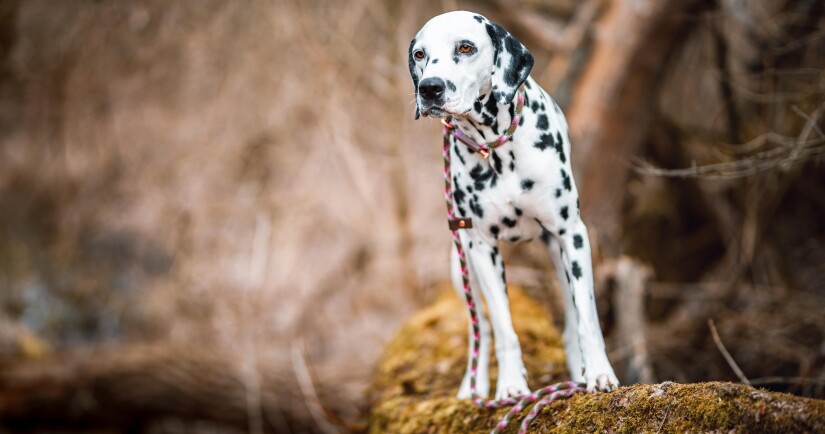
Dalmatians have two health issues. One is congenital deafness which makes it virtually impossible for the dog to lead even a remotely normal life. They can also have partial deafness in the sense that they will only hear with one ear but this isn’t a problem since before people had no way of testing this and never even knew of it.
The other problem consists of a direct excretion of uric acid without conversion into urea. This means that they can develop kidney stones and toxemia however they pass them relatively easily.
Inherited Deafness
A degeneration of internal ear structures occurs a few weeks after birth which results in deafness in one or both ears. Inherited deafness is a common occurrence as it affects many breeds. It is most prevalent in Dalmatians.
For most breeds, the deafness trait is linked with coat color. This is particularly true in breeds with white, merle, dappled, and spotted hair coats. As you can see, the Dalmatian has two of those. So, for him, it’s double jeopardy. Blue eyes also increase the risk of developing deafness.
The incidence of inheritance of deafness in Dalmatians can be as high as 30%. The process is not very well understood, however, efforts are being made to find out the cause and reduce the number of affected dogs.
How do you know if your dog is deaf?
If your dog is only deaf in one ear you will probably never notice it. Puppies will lose hearing a few weeks after birth. The most common signs are aggressive play, because the puppy cannot hear cries of pain, and not wake up to sounds. Unilateral deafness is very hard to spot.
If your Dalmatian has unilateral deafness you will probably just notice he responds a little better to hand signals instead of verbal cues during training. Unless he’s a working dog to whom sound location is important it won’t be a problem.
Bilateral deafness, however, makes it very hard for your dog to lead a normal life. Deafness cannot be cured, and there are no degrees of deafness. Either he has it, or he doesn’t.
How does deafness affect your dog?
As I’ve said, if your dog is only deaf in 1 ear you will probably never have any unusual problems. On the other hand, a totally deaf dog will have many more problems and needs special care.
He will startle easily and is much more difficult to train. Since most dogs respond to praise in the form of a warm tone, if he can’t hear he won’t know what’s going on.
Your only option is to train the dog to respond to hand signals or other visual cues. Even this will not be enough, you will have to always restrain him using either a leash or an enclosed space and you must always be aware that he may bite someone if he’s startled.
It’s important not to breed deaf dogs, even if they have unilateral deafness. This problem affects a significant number of Dalmatians. To help eliminate deafness every Dalmatian should be tested with the BAER test. The Brainstem Auditory-Evoked Response procedure is a non-intrusive, painless test that reliably detects hearing loss, even unilateral deafness.
Many Dalmatians are likely to develop hearing loss in one or both ears. Bilateral deafness is quite debilitating and requires special measures for the dog to lead a normal life. Unilateral deafness is usually not problematic. In fact, you probably won’t even find out about it.
Can Dalmatians and children get along?
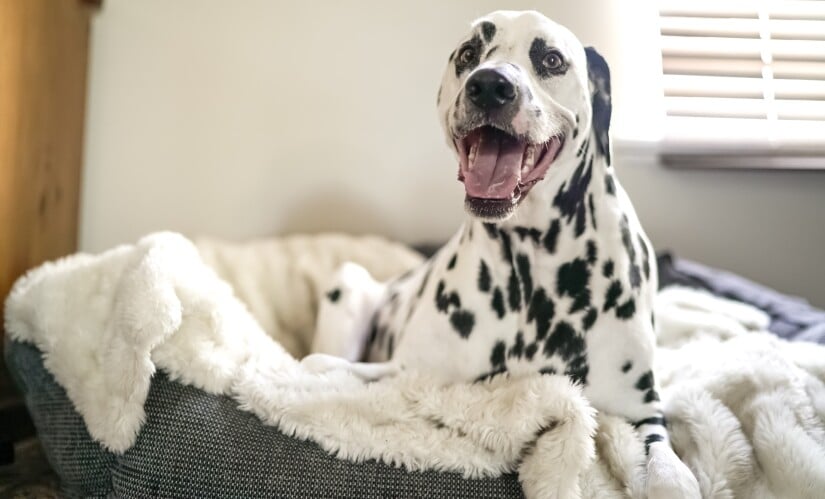
First of all, never let your child be the primary caretaker for your dog. Sure, he can help, and let him do some of the things will build character and will create a good relationship between him and the dog.
However confident you are in your dog and your children’s behavior, never leave them alone together. Teach your child the correct behavior to minimize the chances of unpredictable problems.
Your child should never run up to strange dogs or even touch them without your okay. Never let your child abuse your Dalmatian in any way. Similarly, don’t expect your Dalmatian to put up with endless amounts of teasing. Your dog will probably not be patient unless you specifically teach him to be from a young age.
Dalmatians are great family dogs, always ready to play and a joy to be around. They are great with children overall but there are some things you should be aware of to nurture the relationship between your dog and your child.
Play Rules
Dalmatians are generally good with children, as the affectionate and caring demeanor of the dog will project positively upon your children and their relationship. In fact, you should do whatever you can to ensure they have as good a relationship as possible. This will take the heat off when you’re not home and the child is left with the dog.
At first, it’s advisable to never leave the dog and your child unattended. There are certain things that must be made clear so you have the peace of mind that nothing bad is going to happen when you’re away.
Similarly, if they do get along very well it doesn’t mean you can let the child be the primary caretaker for the dog. That is still your job, and you can’t expect your children to hold that responsibility.
Potential issues you should address
Your child should never scare the dog because that’s when he might react unexpectedly. Teach your child not to scream when he is close to the dog as it might startle him. If your dog is still a puppy don’t let your child carry him around. You never know when he will drop him and he can get seriously injured.
Your children should never tease the dog unnecessarily. It’s fine to let them play; but you have to realize that the Dalmatian doesn’t have endless patience. Unless he’s very well-trained he will likely snap sooner or later.
Don’t let your children walk the dog outside without your supervision. Dalmatians are very strong and are strong-willed to pull on the leash if they sense a lack of control.
Also, if you’re outside and the dog catches a glimpse of a cat or something distracting, he will be too much to handle since he likely weighs more than your child. Another potential problem is strange dogs. If they decide they feel threatened by your Dalmatian your child will not be intimidating to a pack of strange dogs.
Establish rules for other children
Play rules apply not only for your child, but also for other children who come by your house. In fact, they need to know the rules even better because the dog is not as familiar with them as he is with your own children.
Don’t let other children feed the dog unless you are there. The dog should not accept treats from other people if you don’t give him the okay. If he’s well-trained he will wait for your okay even when you are giving him treats.
One very popular mistake that creates tension and hurts the overall quality of your family relationships is to completely ignore the dog when you’re with your child. This way, your Dalmatian will see your child as competition for attention. Never forget to give some attention to the dog even when you’re playing with your child.
The most important thing is to be clear about the boundaries of the interaction between your dog and your child. Never let it get too far and try to always be there to supervise things. Finally, let your child do his part in taking care of your dog.
How to Walk Your Dog On a Leash
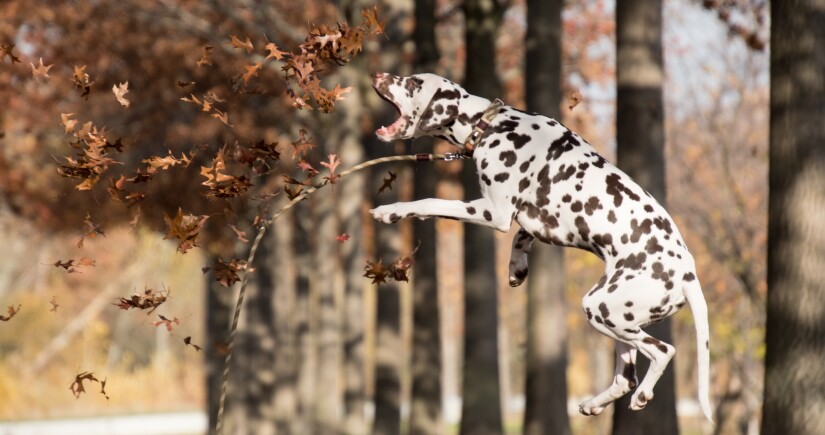
Dalmatians are often regarded as dumb and mindless because they are not easy to train. However, most people don’t realize that intelligence level has nothing to do with how easy a dog is to train. This happens between people as well, but just because someone isn’t willing to do what you want doesn’t mean they’re stupid.
These dogs are clever and are accomplished, food thieves. You look away for 3 seconds and he’s already snatched something. The important thing you need to understand is that Dalmatians are smart, and learn quickly. The problem – why should they obey you?
How to make him listen to you
Most of the time people tend to punish disobedience. If he won’t listen, he’ll suffer for it. I think they couldn’t have a worse idea. Not only will constant punishment make him fear you, but if he had any reason to listen, you can be sure that now it’s totally trashed.
Instead of constantly telling him what he’s not allowed to do and what a bad dog he is you need to reinforce what he does right. You need to answer the question “why” with enthusiasm and positive reinforcement.
Luckily, you have leverage. Dalmatians are very people-oriented and want to be around you and spend time with you. So if he’s a bad dog you don’t have to punish him. All you have to do is ignore him. Piece of cake, right?
If you ignore him he’ll start to wonder why. The clearer you are in your body language the faster he will correct his behavior. This is how you establish a pack leader status. Does he want you? He must obey you.
One of the better habits you can get into is never giving him what he wants until he obeys something. People generally make their dogs sit before receiving anything. For example, if he wants to go out, first he must listen to you a little, and then you’ll provide what he needs.
Dalmatians become very easy to train once they know it’s good to obey you. Their innate intelligence makes them a lot of fun to work with. One task many people have trouble with is walking a Dalmatian on a leash.
Walking your dog on a leash
Dalmatians have a natural tendency to pull on the leash. Their independent mind and curiosity drive them towards every distraction they can find out there. In order to control the dog and stop him from pulling on the leash all the time, you need to teach him that you’re in charge.
Here’s what you need to do. He’s on the leash, the leash is in your hand and you have started your walk. Next thing you know he starts pulling in some random direction. As soon as he starts pulling; stop. Stand still until he stops. He will likely keep trying to pull you for a while.
As soon as he figures out something is wrong and stops you start walking again. A few seconds later he will probably start pulling again. Every time just repeat the process. The catch is that you’re the one who decides when and where you go. So until he listens to you then you’re not going anywhere.
This fast and efficient method can bring your dog under control in as little as 5 minutes. For excessively stubborn dogs it might take longer. It doesn’t make a difference, just keep it up, and sooner than you know it you will be relaxing your way through the park without ever having any trouble with your Dalmatian.
The “Watch Me” command
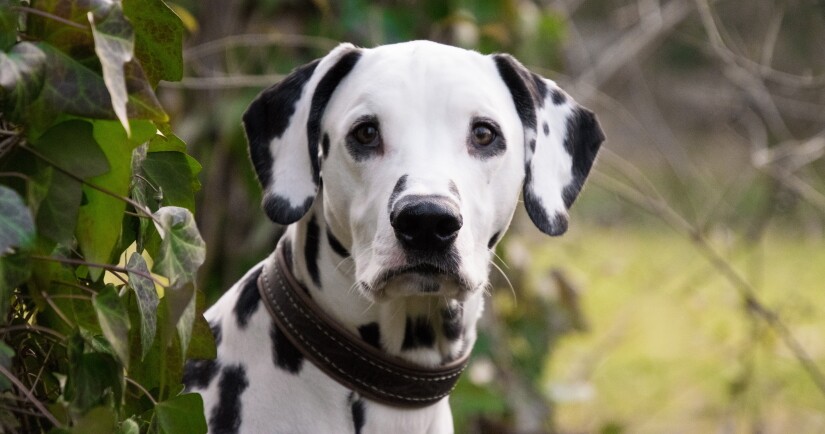
Probably the biggest trouble you can have when training your Dalmatian is actually having him listen to you. Dalmatians are notorious for their independence and their “who cares what you say” attitude. Most people attribute this to some form of stupidity. Obviously, that must be the case.
In reality, Dalmatians simply don’t have a very strong desire to please you just because. You could say they’re too smart. You need to give them a good reason to listen to you. And what better way to a canine’s heart than food?
You’ve probably used this trick even with some random angry dog on the street. Some dogs come barking and growling at you, you pick a hotdog or piece of bread or whatever you have nearby and they immediately turn from hostiles into little puppies. And you’re their best friend.
Most people are very impressed when they see someone who has good control over their dog. Especially when they can shift his attention at will. But, really, it’s not that hard to teach your dog a reliable “watch me” command.
How to teach your Dod the “Watch Me” command
Obviously, almost any dog owner will benefit from having this command firmly implemented in their dogs’ mind. Even more so if your dog is a Dalmatian. Any independent-minded dog who tries to challenge your authority needs to be taught that you’re the boss and that good things happen when he listens to you.
When I say you’re the boss I don’t mean beat or punish your dog. There seems to be this perceived notion that the boss is always a mob-style guy who eliminates anyone who crosses him. No, a boss is a guy that constantly rattles on about how bad you are at your job and what a miserable performance you do. But I digress.
Boss, in our context, means that you’re the guy in control. You’re the pack leader. And, I say again, the most important aspect is that good things happen around you. You’re a fountain of goodwill, love, and generosity. Act like it.
The “Watch Me” command is pretty easy to teach
You may feel a little silly, you may feel like you’re doing some Vulcan mind-melding forehead power-action. Regardless, you won’t be disappointed. Start by grabbing a treat, holding it between your eyes, and saying “Watch Me.” He will be staring greedily at the treat, but at least he’s looking in your direction.
As soon as he looks at you say “good Watch Me” and reward him with the treat you held in your hand. After a couple more tries he’ll be looking at you consistently. It’s time to up your game.
This time hold the treat inside your hand where he can’t see it, but still, put your hand up near your face. Say “Watch Me” and if he looks at you praise and reward him. If he looks at your hand say “uh-uh, watch me”. When he looks at you again praise and reward him.
If he doesn’t get it hold the treat in front of your eyes again and tell him to watch you again. Start mixing up where you hold the treat. One time in front of your eyes, the next two in your hand, the next 3 in front of your eyes.
When you always have the treat outside your dogs’ sight and he still looks at you start lengthening the time he has to look at you before you give him the treat. Up to 10 times a day of practice is more than enough for this command.
After a few days, you’ll have your reliable watch me command which you can start trying in more distracting environments. Eventually, you’ll be able to always demand your dog’s attention when you want it.
Playing Hide and Seek
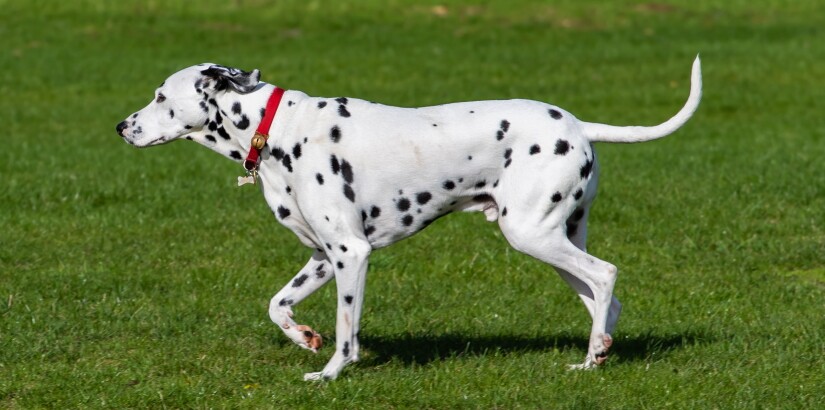
Playing games with your Dalmatian not only keeps him worked out and content, it also shows him how much fun you are. You are constantly coming up with new things for you to do and he’s in a continuous state of happiness just because he is with you.
This kind of relationship also builds trust and understanding. And don’t even think that you could get bored. If you ever imagined you would get bored of your dog at some point now’s the time to realize it can’t happen. Not only are you coming with new and interesting things to do, but you will also see that because you’re showing so much affection and variety to your Dalmatian he will start offering new behaviors that are fun and entertaining.
Hide and seek used to be the deal when we were kids. This was probably the most played game in my neighborhood, probably in your neighborhood too. That and a primitive version of paintball. Ah, those were the days. You get a chance to relive some of the joy of hide and seek if you have a dog that knows how to stay.
This is another game that doesn’t require any form of physical fitness for either you or your Dalmatian. It can be done in your house, backyard or park. Wherever and whenever. It’s a very easy game but it contributes a big part to your Dalmatian’s mental workout.
How to play hide and seek
For this game to work, you need to teach him a reliable Stay command first. Otherwise, he’ll come looking for you before you even leave the room. You won’t have time to hide!
Start by setting your dog comfortably in one place (comfortable means sit or down) and telling him to stay. Then you go hide and call him. When he finds you you praise him big time and give him a nice treat.
That’s all there is to it. But don’t start with hiding in the closet or something. At first, just go around the corner and call him. When he finds you praise and reward him.
One thing you have to look out for is hiding every time you say “Stay.” If you do that he will start associating stay with you wanting to be away from him. Then he’ll start following you around the minute you turn. Instead, sometimes come back to him after going around the corner and praise and reward him for a good Stay.
It’s important for the dog to realize that this is a game you’re playing together, you’re not trying to get rid of him. Once he finds you in easy places you can start hiding in tougher spots.
How is this beneficial for you and your dog?
To understand how this simple game is perceived by your dog you need to go into his perspective. What do you think he thinks? He thinks that he has used his senses to find his most beloved. What could be greater than rejoining with the pack?
This sort of simple mental workout is the foundation for a healthy Dalmatian. It’s also a great source of fun. Once he’s down with the game you can start playing with your kids and other people. Children absolutely love this game.
One thing you might not consider is that these games are a form of training. You are playing with a new behavior that your dog must learn. The joy comes when he gets it when he understands. In other words, when the “training” is successful.
If you had any misconceptions about how serious or boring training is this game should shed the light. Training is supposed to be fun. If it isn’t your Dalmatian won’t have a minute of it. Enjoy the pride of owning such a clever dog.
Dalmatian Rescue Groups
Dalmatian Rescue of Southern California
- Address
- Newport Beach, CA, USA
- Website
- www.dalrescuesocal.com
- dalrescue@sbcglobal.net
Dalmatian Rescue of Colorado
- Address
- Loveland, CO, USA
- Website
- www.dalmatianrescueco.org
- Phone
- (970) 2261316
- info@dalmatianrescueco.org
Dalmatian Rescue of North Texas
- Address
- Plano, TX, USA
- Website
- www.dalpal.com
- Phone
- (972) 250DALS
- adoptme@dalpal.com
Willing Hearts Dalmatian Rescue
- Address
- Royersford, PA, USA
- Website
- www.whdr.org
- Phone
- (610) 3427237
- dalmatianrescue@comcast.net
Dalmatian Rescue of Puget Sound
- Address
- Lake Stevens, WA, USA
- Website
- www.dalmatianrescueofpugetsound.com
- Phone
- (360) 5689504
- rescue@dalmatianrescueofpugetsound.org
Dalmatian Adoption and Rescue
- Address
- Ontario, Canada
- Website
- www.dalrescue.org
- Phone
- (416) 6532411
- dalrescue@hotmail.com
See Spot Smile Dalmatian Rescue
- Address
- Vancouver Island, British Columbia, Canada
- Website
- www.seespotsmile.org
- Phone
- (250) 6504477
- pals4dals03@yahoo.ca
British Dalmatian Welfare
- Address
- Buckingham, United Kingdon
- Website
- www.dalmatianwelfare.co.uk
- Phone
- (07976) 360468
DAS Dalmatians
- Address
- United Kingdom
- Website
- www.dasdalmatians.co.uk
- info@dasdogs.co.uk
Breeders in the USA
Snowood Dalmatians & Cavaliers (Illinois)
- Address
- Garden Prairie, IL
- Website
- www.snowood.net
- Phone
- (815) 5974601
- meg@snowood.net
HatTrick Dalmatians (Texas)
- Address
- Aledo, TX
- Website
- www.hattrickdalmatians.com
- Phone
- (817) 4580565
- hattrick-dals@att.net
Stagecoach Dalmatians (Maryland)
- Address
- Edgewater, MD
- Website
- www.stagecoachdalmatian.com
- Phone
- (410) 3539430
- t1brumfield@aol.com
Rose Valley Kennel (Maryland)
- Address
- Sharpsburg, MD
- Website
- www.facebook.com/DebsDals
- Phone
- (240) 6753212
- dsadler101@yahoo.com
Olympus Dalmatians & Cocker Spaniels (Kentucky)
- Address
- Guston, KY
- Website
- www.facebook.com/olympusdals
- Phone
- (502) 8210604
- dalmatian.nation@yahoo.com
Alpha N Omega Dalmatians (Connecticut)
- Address
- East Granby, CT
- Website
- www.alpha-n-omega-dalmatians.com
- spotseverywhere@alpha-n-omega-dalmatians.com
Andiron Dalmatians (Pennsylvania)
- Address
- North East, PA
- Website
- www.andironspots.com
- Phone
- (814) 4902137
RJ’s Dalmatians (Pennsylvania)
- Address
- Liberty, PA
- Website
- www.rjsdalmatians.org
- Phone
- (272) 2099777
- rjsdalmatians@gmail.com
Smiling Dalmatians (Idaho)
- Address
- Grangeville, ID
- Website
- www.smilingdalmatians.com
- Phone
- (559) 2881317
- karen@smilingdalmatians.com
Darrfield (Virginia)
- Address
- Chesterfield, VA
- Website
- www.darrfield.godaddysites.com
- Phone
- (804) 2298599
- desdarr3416@gmail.com
Opal-onyx Dalmatians (Florida)
- Address
- Morriston, FL
- Website
- www.opal-onyx.com
- Phone
- (954) 6573159
- info@opal-onyx.com
Dottie’s Dals (California)
- Address
- Cupertino, CA
- Website
- www.dalmatian.us
- Phone
- (408) 9871889
- nronhansen@gmail.com
Diamond D Dalmatians (Indiana)
- Address
- Palmyra, IN
- Website
- www.dymondeedals.com
- Phone
- (630) 5511628
- dymondal101@gmail.com
Breeders in Canada
Echo View
- Address
- Rocky Mountain House, Alberta
- Website
- www.echoview.ca
- Phone
- (403) 7292227
- jbh@echoview.ca
Redrock
- Address
- Alberta
- Website
- www.redrockkennels.ca
- Phone
- (403) 8663875
- ryankait.glass@gmail.com
SevenMoons
- Address
- Edmonton, Alberta
- Website
- www.facebook.com/sevenmoonskennel
- sevenmoonskennel@gmail.com
Winterspear
- Address
- Warburg, Alberta
- Website
- www.winterspearkennels.ca
- Phone
- (780) 8610263
- winterspeardals@gmail.com
Highgate Dalmatians
- Address
- Vancouver Island, British Columbia
- Website
- www.highgate-dalmatians.com
- dara.ashton@gmail.com
DotsOn
- Address
- Val-des-Monts, Québec
- Website
- www.dotson-dalmatian.com
- dots-on@live.ca
Breeders in the Great Britain
Dalstorm Dalmatians
- Address
- United Kingdom
- Website
- www.dalstorm.co.uk
- Phone
- (07710) 418065
- elizabethsampson@me.com
Luccombe Dalmatians
- Address
- Derbyshire
- Website
- www.luccombedalmatians.com
- Phone
- (01332) 880470
- sharonridgway123@btinternet.com
Koroyza Dalmatians
- Address
- West Yorkshire
- Website
- www.koroyza.co.uk
- Phone
- (07796) 512692
Tippledal Dalmatians
- Address
- Wales
- Website
- www.tippledal.weebly.com
- tippledal@yahoo.com
